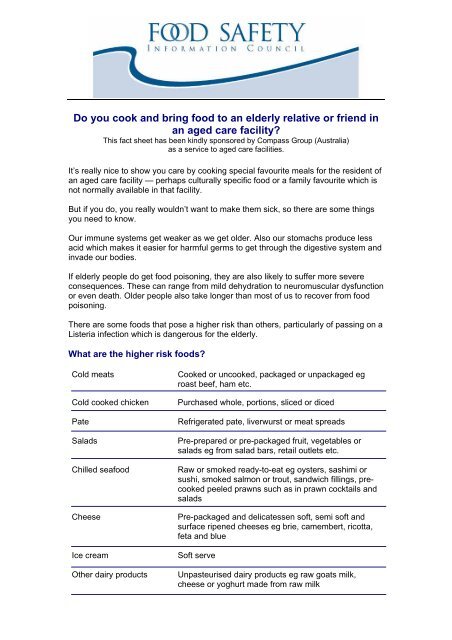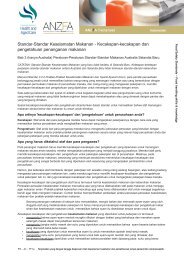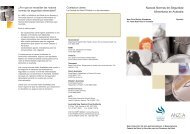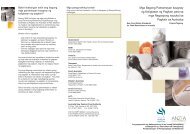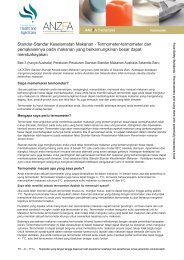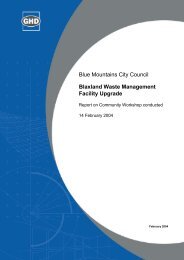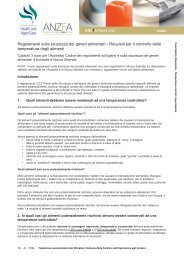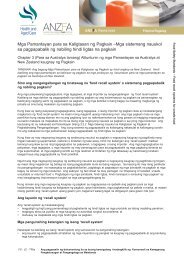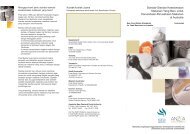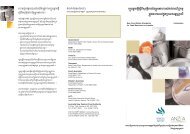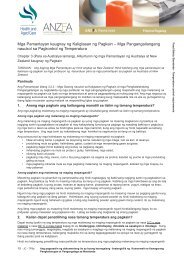Do you cook and bring food to an elderly relative or friend in an ...
Do you cook and bring food to an elderly relative or friend in an ...
Do you cook and bring food to an elderly relative or friend in an ...
You also want an ePaper? Increase the reach of your titles
YUMPU automatically turns print PDFs into web optimized ePapers that Google loves.
<strong>Do</strong> <strong>you</strong> <strong>cook</strong> <strong><strong>an</strong>d</strong> <strong>br<strong>in</strong>g</strong> <strong>food</strong> <strong>to</strong> <strong>an</strong> <strong>elderly</strong> <strong>relative</strong> <strong>or</strong> <strong>friend</strong> <strong>in</strong><br />
<strong>an</strong> aged care facility<br />
This fact sheet has been k<strong>in</strong>dly spons<strong>or</strong>ed by Compass Group (Australia)<br />
as a service <strong>to</strong> aged care facilities.<br />
It’s really nice <strong>to</strong> show <strong>you</strong> care by <strong>cook</strong><strong>in</strong>g special favourite meals f<strong>or</strong> the resident of<br />
<strong>an</strong> aged care facility — perhaps culturally specific <strong>food</strong> <strong>or</strong> a family favourite which is<br />
not n<strong>or</strong>mally available <strong>in</strong> that facility.<br />
But if <strong>you</strong> do, <strong>you</strong> really wouldn’t w<strong>an</strong>t <strong>to</strong> make them sick, so there are some th<strong>in</strong>gs<br />
<strong>you</strong> need <strong>to</strong> know.<br />
Our immune systems get weaker as we get older. Also our s<strong>to</strong>machs produce less<br />
acid which makes it easier f<strong>or</strong> harmful germs <strong>to</strong> get through the digestive system <strong><strong>an</strong>d</strong><br />
<strong>in</strong>vade our bodies.<br />
If <strong>elderly</strong> people do get <strong>food</strong> poison<strong>in</strong>g, they are also likely <strong>to</strong> suffer m<strong>or</strong>e severe<br />
consequences. These c<strong>an</strong> r<strong>an</strong>ge from mild dehydration <strong>to</strong> neuromuscular dysfunction<br />
<strong>or</strong> even death. Older people also take longer th<strong>an</strong> most of us <strong>to</strong> recover from <strong>food</strong><br />
poison<strong>in</strong>g.<br />
There are some <strong>food</strong>s that pose a higher risk th<strong>an</strong> others, particularly of pass<strong>in</strong>g on a<br />
Listeria <strong>in</strong>fection which is d<strong>an</strong>gerous f<strong>or</strong> the <strong>elderly</strong>.<br />
What are the higher risk <strong>food</strong>s<br />
Cold meats<br />
Cold <strong>cook</strong>ed chicken<br />
Pate<br />
Salads<br />
Chilled sea<strong>food</strong><br />
Cheese<br />
Ice cream<br />
Other dairy products<br />
Cooked <strong>or</strong> un<strong>cook</strong>ed, packaged <strong>or</strong> unpackaged eg<br />
roast beef, ham etc.<br />
Purchased whole, p<strong>or</strong>tions, sliced <strong>or</strong> diced<br />
Refrigerated pate, liverwurst <strong>or</strong> meat spreads<br />
Pre-prepared <strong>or</strong> pre-packaged fruit, vegetables <strong>or</strong><br />
salads eg from salad bars, retail outlets etc.<br />
Raw <strong>or</strong> smoked ready-<strong>to</strong>-eat eg oysters, sashimi <strong>or</strong><br />
sushi, smoked salmon <strong>or</strong> trout, s<strong><strong>an</strong>d</strong>wich fill<strong>in</strong>gs, pre<strong>cook</strong>ed<br />
peeled prawns such as <strong>in</strong> prawn cocktails <strong><strong>an</strong>d</strong><br />
salads<br />
Pre-packaged <strong><strong>an</strong>d</strong> delicatessen soft, semi soft <strong><strong>an</strong>d</strong><br />
surface ripened cheeses eg brie, camembert, ricotta,<br />
feta <strong><strong>an</strong>d</strong> blue<br />
Soft serve<br />
Unpasteurised dairy products eg raw goats milk,<br />
cheese <strong>or</strong> yoghurt made from raw milk
Foods made with raw egg such as home-made egg mayonnaise, holl<strong><strong>an</strong>d</strong>aise sauce,<br />
un<strong>cook</strong>ed cakes <strong><strong>an</strong>d</strong> desserts <strong><strong>an</strong>d</strong> egg-nog c<strong>an</strong> also be d<strong>an</strong>gerous f<strong>or</strong> the <strong>elderly</strong>.<br />
You should not provide these <strong>food</strong>s <strong>to</strong> <strong>an</strong> <strong>elderly</strong> resident<br />
The <strong>elderly</strong> person may also have special dietary requirements <strong>or</strong> restrictions of<br />
which <strong>you</strong> are unaware. Please check with the staff bef<strong>or</strong>e provid<strong>in</strong>g <strong>food</strong> <strong>to</strong> <strong>an</strong><br />
<strong>elderly</strong> resident.<br />
What precautions should I take when prepar<strong>in</strong>g <strong>food</strong>s<br />
There are no special rules f<strong>or</strong> <strong>cook</strong><strong>in</strong>g f<strong>or</strong> <strong>elderly</strong> people — <strong>you</strong> just need <strong>to</strong> be even<br />
fussier th<strong>an</strong> n<strong>or</strong>mal. If <strong>you</strong> pl<strong>an</strong> <strong>to</strong> take chilled <strong>or</strong> frozen <strong>food</strong> <strong>you</strong> have <strong>cook</strong>ed<br />
<strong>you</strong>rself, make sure that the <strong>food</strong> is cooled quickly <strong>in</strong> <strong>you</strong>r refrigera<strong>to</strong>r; never at room<br />
temperature. Always wash <strong>you</strong>r h<strong><strong>an</strong>d</strong>s well under runn<strong>in</strong>g water us<strong>in</strong>g soap <strong><strong>an</strong>d</strong> dry<br />
th<strong>or</strong>oughly bef<strong>or</strong>e h<strong><strong>an</strong>d</strong>l<strong>in</strong>g <strong>food</strong>. You c<strong>an</strong> get <strong>in</strong>f<strong>or</strong>mation on prepar<strong>in</strong>g <strong>food</strong> safely<br />
from the fact sheet ‘Protect<strong>in</strong>g T<strong>in</strong>y Tummies <strong><strong>an</strong>d</strong> Sensitive Systems’ <strong><strong>an</strong>d</strong> other fact<br />
sheets on the Food Safety Inf<strong>or</strong>mation Council website, www.<strong>food</strong>safety.asn.au.<br />
How c<strong>an</strong> I tr<strong>an</strong>sp<strong>or</strong>t <strong>food</strong> safely f<strong>or</strong> <strong>an</strong> <strong>elderly</strong> person<br />
You will need <strong>to</strong> tr<strong>an</strong>sp<strong>or</strong>t <strong>you</strong>r <strong>food</strong> <strong>to</strong> the aged care facility so take care that it is<br />
protected from contam<strong>in</strong>ation dur<strong>in</strong>g tr<strong>an</strong>sp<strong>or</strong>t <strong><strong>an</strong>d</strong>, if it is chilled <strong>food</strong>, it is kept cool<br />
<strong>or</strong> if <strong>you</strong> are tak<strong>in</strong>g it hot, <strong>you</strong> keep it hot dur<strong>in</strong>g the journey.<br />
Food should be kept at 5 degrees Celsius <strong>or</strong> cooler <strong>or</strong>, f<strong>or</strong> hot <strong>food</strong>, at 60 degrees<br />
Celsius <strong>or</strong> hotter. Between 5 <strong><strong>an</strong>d</strong> 60 degrees is known as the temperature d<strong>an</strong>ger<br />
zone because harmful bacteria multiply <strong>to</strong> d<strong>an</strong>gerous levels <strong>in</strong> <strong>food</strong> when it is kept<br />
between these temperatures.<br />
Put cold <strong>food</strong> <strong>in</strong><strong>to</strong> a cooler with ice packs when travell<strong>in</strong>g <strong>to</strong> visit <strong>you</strong>r <strong>relative</strong> <strong>or</strong><br />
<strong>friend</strong>. <strong>Do</strong>n' t pack <strong>food</strong> if it has just been <strong>cook</strong>ed <strong><strong>an</strong>d</strong> is still warm. Coolers c<strong>an</strong>not<br />
cool <strong>food</strong> they c<strong>an</strong> only keep cold <strong>food</strong> cool. Always cover pre-prepared <strong>food</strong>s<br />
securely <strong><strong>an</strong>d</strong> prechill them, f<strong>or</strong> example, keep <strong>in</strong> the refrigera<strong>to</strong>r overnight. Other<br />
perishable <strong>food</strong>s <strong><strong>an</strong>d</strong> dr<strong>in</strong>ks, such as deli products, <strong>cook</strong>ed chicken <strong><strong>an</strong>d</strong> dairy<br />
products must also be cold when put <strong>in</strong> the cooler.<br />
Hot <strong>food</strong> is difficult <strong>to</strong> keep hot <strong><strong>an</strong>d</strong> is best avoided if <strong>you</strong> are travell<strong>in</strong>g long<br />
dist<strong>an</strong>ces. It is best <strong>to</strong> chill the <strong>food</strong> overnight <strong><strong>an</strong>d</strong> reheat it at the residence. If <strong>you</strong><br />
must take hot <strong>food</strong> on a longer journey, <strong>an</strong> <strong>in</strong>sulated jug, preheated with boil<strong>in</strong>g water<br />
bef<strong>or</strong>e be<strong>in</strong>g filled with the steam<strong>in</strong>g hot <strong>food</strong>, c<strong>an</strong> be used. If <strong>you</strong> are unsure whether<br />
the jug will keep the <strong>food</strong> above 60 degrees Celsius, try fill<strong>in</strong>g it with water at 90<br />
degrees Celsius, seal <strong><strong>an</strong>d</strong> test the water temperature after the length of time <strong>you</strong><br />
expect <strong>you</strong>r journey <strong>to</strong> take. If it is still above 60 degrees then <strong>you</strong> c<strong>an</strong> use the jug.<br />
You will need a <strong>food</strong> thermometer <strong>to</strong> do this test.<br />
If <strong>an</strong>y perishable <strong>food</strong> <strong>you</strong> <strong>br<strong>in</strong>g</strong> is not eaten immediately, make sure it is refrigerated<br />
bef<strong>or</strong>e <strong>you</strong> leave.
Reheat<strong>in</strong>g <strong>food</strong><br />
Different aged care facilities will have different rules about reheat<strong>in</strong>g <strong>food</strong> provided by<br />
<strong>friend</strong>s <strong>or</strong> <strong>relative</strong>s. In some, staff will reheat the <strong>food</strong>, <strong>in</strong> others, staff are not<br />
permitted <strong>to</strong> do so. In some facilities, the <strong>elderly</strong> person c<strong>an</strong> reheat the <strong>food</strong><br />
themselves, <strong>in</strong> others the person provid<strong>in</strong>g the <strong>food</strong> must do the reheat<strong>in</strong>g.<br />
Check with the staff <strong>to</strong> f<strong>in</strong>d out the rules <strong>in</strong> that facility. Make sure that staff know that<br />
<strong>you</strong> have brought <strong>in</strong> <strong>food</strong> <strong><strong>an</strong>d</strong> ask them how <strong>to</strong> go about re-heat<strong>in</strong>g it.<br />
Food needs <strong>to</strong> be reheated <strong>to</strong> a m<strong>in</strong>imum of 75 degrees Celsius <strong>or</strong> 70 degrees<br />
Celsius f<strong>or</strong> two m<strong>in</strong>utes <strong>to</strong> kill <strong>an</strong>y bacteria <strong>or</strong> viruses that might be present <strong>in</strong> the<br />
<strong>food</strong>.<br />
Reheat<strong>in</strong>g <strong>food</strong> <strong>in</strong> a microwave oven<br />
If <strong>you</strong> are reheat<strong>in</strong>g <strong>food</strong> <strong>in</strong> a microwave, <strong>you</strong> need <strong>to</strong> be especially careful that the<br />
<strong>food</strong> is heated evenly.<br />
Food heated <strong>in</strong> a microwave oven does not heat unif<strong>or</strong>mly <strong><strong>an</strong>d</strong> unw<strong>an</strong>ted germs may<br />
survive <strong>in</strong> p<strong>or</strong>tions of po<strong>or</strong>ly heated <strong>food</strong>.<br />
M<strong>an</strong>ufacturers recommend st<strong><strong>an</strong>d</strong><strong>in</strong>g times <strong>to</strong> help alleviate the problem of uneven<br />
heat<strong>in</strong>g. M<strong>an</strong>y microwaveable meal packs carry the <strong>in</strong>struction <strong>to</strong> stir the <strong>food</strong> part<br />
way through the <strong>cook</strong><strong>in</strong>g process. Items such as lasagne that c<strong>an</strong>'t be stirred should<br />
be allowed st<strong><strong>an</strong>d</strong><strong>in</strong>g time <strong>to</strong> allow the whole product <strong>to</strong> reach a unif<strong>or</strong>m temperature.<br />
How evenly the <strong>food</strong> will heat will also depend on the thickness of p<strong>or</strong>tions <strong><strong>an</strong>d</strong> on<br />
the composition <strong><strong>an</strong>d</strong> moisture content of the <strong>food</strong>.<br />
Frozen <strong>food</strong> needs <strong>to</strong> be completely thawed bef<strong>or</strong>e reheat<strong>in</strong>g.<br />
If <strong>you</strong> are reheat<strong>in</strong>g a commercially prepared <strong>food</strong>, read <strong><strong>an</strong>d</strong> follow all the<br />
m<strong>an</strong>ufacturer’s microwav<strong>in</strong>g <strong>in</strong>structions.<br />
S<strong>to</strong>rage of the <strong>food</strong> <strong>you</strong> <strong>br<strong>in</strong>g</strong> <strong>in</strong><br />
If some <strong>or</strong> all of <strong>an</strong>y perishable <strong>food</strong> <strong>you</strong> have provided is not eaten immediately, tell<br />
the staff <strong><strong>an</strong>d</strong> ask them about s<strong>to</strong>r<strong>in</strong>g the <strong>food</strong> <strong>in</strong> a refrigera<strong>to</strong>r.<br />
Some <strong>elderly</strong> people like <strong>to</strong> keep extra <strong>food</strong> <strong>in</strong> their rooms <strong>in</strong> drawers <strong>or</strong> bedside<br />
tables f<strong>or</strong> eat<strong>in</strong>g later. Whilst this is <strong>an</strong> acceptable practice f<strong>or</strong> shelf stable <strong>food</strong>s like<br />
cakes, biscuits <strong><strong>an</strong>d</strong> chocolates, this c<strong>an</strong> be very risky with perishable <strong>food</strong> such as<br />
cold meats, custard <strong>or</strong> cream filled cakes <strong><strong>an</strong>d</strong> <strong>cook</strong>ed vegetables <strong><strong>an</strong>d</strong> meat dishes.<br />
Leav<strong>in</strong>g perishable <strong>food</strong> <strong>in</strong> the temperature d<strong>an</strong>ger zone f<strong>or</strong> <strong>to</strong>o long bef<strong>or</strong>e be<strong>in</strong>g<br />
eaten c<strong>an</strong> result <strong>in</strong> <strong>food</strong>b<strong>or</strong>ne illness. Food which c<strong>an</strong> cause <strong>food</strong> poison<strong>in</strong>g may not<br />
look <strong>or</strong> taste spoiled.<br />
Sometimes <strong>elderly</strong> people c<strong>an</strong> also f<strong>or</strong>get how long the <strong>food</strong> has been there.
If <strong>you</strong> <strong>br<strong>in</strong>g</strong> <strong>an</strong> unopened package of commercially prepared <strong>food</strong><br />
Make sure the <strong>elderly</strong> person is aware of <strong>an</strong>y ‘best bef<strong>or</strong>e’ <strong>or</strong> ‘use by’ date on the<br />
<strong>food</strong> package.<br />
Remember:<br />
Make sure <strong>you</strong> tell the staff if the <strong>elderly</strong> person has some<br />
perishable <strong>food</strong> <strong>in</strong> their room.<br />
When <strong>you</strong> <strong>br<strong>in</strong>g</strong> <strong>food</strong> <strong>in</strong><strong>to</strong> <strong>an</strong> aged care facility f<strong>or</strong> a <strong>relative</strong> <strong>or</strong> <strong>friend</strong> it is <strong>you</strong><br />
<strong><strong>an</strong>d</strong> not the staff who is responsible f<strong>or</strong> its safety.<br />
If <strong>you</strong> are <strong>cook</strong><strong>in</strong>g f<strong>or</strong> <strong>an</strong> <strong>elderly</strong> person, please check the fact sheet ‘Protect<strong>in</strong>g T<strong>in</strong>y<br />
Tummies <strong><strong>an</strong>d</strong> Sensitive Systems’ under ‘publications’ on the Food Safety Inf<strong>or</strong>mation<br />
Council’s website www.<strong>food</strong>safety.asn.au f<strong>or</strong> m<strong>or</strong>e <strong>in</strong>f<strong>or</strong>mation on prepar<strong>in</strong>g <strong>food</strong><br />
safely.<br />
Need m<strong>or</strong>e <strong>in</strong>f<strong>or</strong>mation<br />
Telephone Project Co-<strong>or</strong>d<strong>in</strong>a<strong>to</strong>r: 0407 626 688<br />
Email:<br />
<strong>in</strong>fo@<strong>food</strong>safety.asn.au<br />
Website:<br />
www.<strong>food</strong>safety.asn.au<br />
Oc<strong>to</strong>ber 2004


